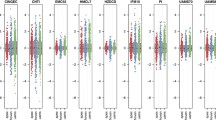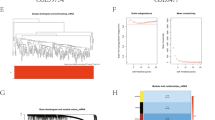Abstract
Multiple myeloma (MM) is a kind of aggressive tumor prevalent with high heterogeneity. Abnormal expression of certain genes may lead to the occurrence and development of MM. Nowadays, it is not commonly seen in clinical research to predict the prognostic circumstances of patients with MM by multiple gene expression profiling method. Identification of potential genes in prognostic process could be beneficial for clinical management of MM. Therefore, we aimed to build a risk fraction model to screen out the prognostic indicator for clinical outcome of MM. Microarray data were downloaded from the Genome Expression Omnibus (GEO) datasets with accession numbers GSE24080 and GSE57317. A total of 279 samples were selected out randomly. Besides, a risk formula was constructed and verified in the dataset. Time-dependent receiver operating characteristic (ROC) curve was applied in evaluating the accurate prognostic conditions of patients. Finally, a ten genes model in the training dataset was found to be closely related to the survival condition of MM patients. Patients with MM were divided into two groups, high-risk and low-risk, by the expression of these ten genes, and significant statistical difference was found between the two groups. Furthermore, the result of multivariate cox regression and stratified analysis indicated that this model was independent of other clinical phenotypes. ROC curves also showed its feasibility to predict the survival status of MM patients. Our results demonstrated that the fraction risk model constructed by the selected ten genes could be used to predict survival status of multiple myeloma patients, which could also help in improvement of prognostic and therapeutic tool of MM.






Similar content being viewed by others
References
Munshi NC, Anderson KC, Bergsagel PL, Shaughnessy J, Palumbo A, Durie B, Fonseca R, Stewart AK, Harousseau J-L, Dimopoulos M. Consensus recommendations for risk stratification in multiple myeloma: report of the international myeloma workshop consensus panel 2. Blood. 2011;117:4696–700.
Decaux O, Lodé L, Magrangeas F, Charbonnel C, Gouraud W, Jézéquel P, Attal M, Harousseau J-L, Moreau P, Bataille R. Prediction of survival in multiple myeloma based on gene expression profiles reveals cell cycle and chromosomal instability signatures in high-risk patients and hyperdiploid signatures in low-risk patients: a study of the intergroupe francophone du myelome. J Clin Oncol. 2008;26:4798–805.
Kumar SK, Rajkumar SV, Dispenzieri A, Lacy MQ, Hayman SR, Buadi FK, Zeldenrust SR, Dingli D, Russell SJ, Lust JA. Improved survival in multiple myeloma and the impact of novel therapies. Blood. 2008;111:2516–20.
Tran B, Dancey JE, Kamel-Reid S, McPherson JD, Bedard PL, Brown AM, Zhang T, Shaw P, Onetto N, Stein L, Hudson TJ, Neel BG, Siu LL. Cancer genomics: technology, discovery, and translation. Cancer genomics: technology, discovery, and translation. J Clin Oncol. 2012;30(6):647–60.
Arpino G, Generali D, Sapino A, Del Matro L, Frassoldati A, de Laurentis M, Pronzato P, Mustacchi G, Cazzaniga M, De Placido S. Gene expression profiling in breast cancer: a clinical perspective. Breast. 2013;22:109–20.
Gray RG, Quirke P, Handley K, Lopatin M, Magill L, Baehner FL, Beaumont C, Clark-Langone KM, Yoshizawa CN, Lee M. Validation study of a quantitative multigene reverse transcriptase–polymerase chain reaction assay for assessment of recurrence risk in patients with stage ii colon cancer. J Clin Oncol. 2011;29:4611–9.
Choudhury AD, Eeles R, Freedland SJ, Isaacs WB, Pomerantz MM, Schalken JA, Tammela TL, Visakorpi T. The role of genetic markers in the management of prostate cancer. Eur Urol. 2012;62:577–87.
Alizadeh AA, Gentles AJ, Alencar AJ, Liu CL, Kohrt HE, Houot R, Goldstein MJ, Zhao S, Natkunam Y, Advani RH. Prediction of survival in diffuse large b-cell lymphoma based on the expression of 2 genes reflecting tumor and microenvironment. Blood. 2011;118:1350–8.
Consortium M. The microarray quality control (maqc)-ii study of common practices for the development and validation of microarray-based predictive models. Nat Biotechnol. 2010;28:827–38.
Gevaert O, Xu J, Hoang CD, Leung AN, Xu Y, Quon A, Rubin DL, Napel S, Plevritis SK. Non–small cell lung cancer: identifying prognostic imaging biomarkers by leveraging public gene expression microarray data—methods and preliminary results. Radiology. 2012;264:387–96.
Harbron C, Chang K-M, South MC. Refplus: an r package extending the rma algorithm. Bioinformatics. 2007;23:2493–4.
Proaño A, Aragón RE, Proaño JL. Escore z: Fenton 2013. Atualizacão de dez anos. J Pediatr. 2014;90:426.
Jiang H, Wong WH. Seqmap: mapping massive amount of oligonucleotides to the genome. Bioinformatics. 2008;24:2395–6.
O’Quigley J, Moreau T. Cox’s regression model: computing a goodness of fit statistic. Comput Methods Prog Biomed. 1986;22:253–6.
Pedersen PA, Kristensen FB. The Danish medical statistics and Danish practical research. Ugeskr Laeger. 1990;152:828–9.
Kyle RA. Multiple myeloma: review of 869 cases. Mayo Clin Proc. 1975;50:29–40.
Bataille R, Boccadoro M, Klein B, Durie B, Pileri A. C-reactive protein and beta-2 microglobulin produce a simple and powerful myeloma staging system. Blood. 1992;80:733–7.
Dimopoulos MA, Barlogie B, Smith TL, Alexanian R. High serum lactate dehydrogenase level as a marker for drug resistance and short survival in multiple myeloma. Ann Intern Med. 1991;115:931–5.
Seidel C, Hjertner Ø, Abildgaard N, Heickendorff L, Hjorth M, Westin J, Nielsen JL, Hjorth-Hansen H, Waage A, Sundan A. Serum osteoprotegerin levels are reduced in patients with multiple myeloma with lytic bone disease. Blood. 2001;98:2269–71.
Heagerty PJ, Lumley T, Pepe MS. Time-dependent roc curves for censored survival data and a diagnostic marker. Biometrics. 2000;56:337–44.
Author information
Authors and Affiliations
Corresponding authors
Additional information
Ai-Xin Hu and Zhi-Yong Huang are co-first authors.
Electronic supplementary material
13277_2016_5449_MOESM1_ESM.doc
Supplement Table 1 (DOC 35 kb)
Rights and permissions
About this article
Cite this article
Hu, AX., Huang, ZY., Liu, P. et al. A new ten-gene risk fraction model serving as prognostic indicator for clinical outcome of multiple myeloma. Tumor Biol. 37, 15967–15975 (2016). https://doi.org/10.1007/s13277-016-5449-4
Received:
Accepted:
Published:
Issue Date:
DOI: https://doi.org/10.1007/s13277-016-5449-4




